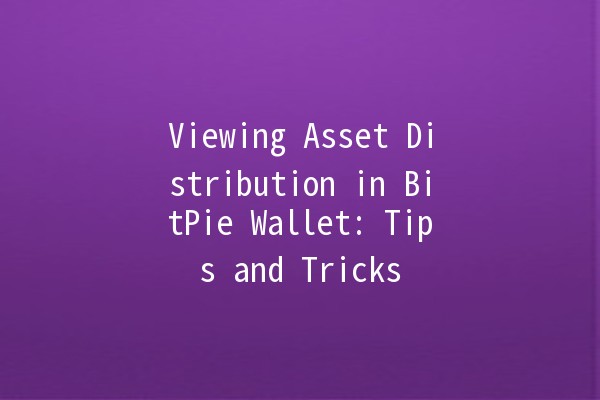
The digital finance landscape is everevolving, and with it comes the necessity to manage your assets effectively. One of the leading wallets integrating various cryptocurrencies is BitPie. Understanding how to view your asset distribution within BitPie is crucial for making informed financial decisions. In this article, we will explore practical tips to optimize your experience and ensure effective tracking of your assets.
Understanding Asset Distribution
Asset distribution refers to the categorization and allocation of your cryptocurrency holdings within your wallet. It can provide insights into your investment strategy, allowing you to assess your exposure to different asset types, thereby enhancing your decisionmaking processes.
Why Asset Distribution Matter?

Practical Tips to View Asset Distribution in BitPie Wallet
Description: The BitPie wallet dashboard is designed to provide a comprehensive overview of your asset distribution.
Implementation:
Open your BitPie wallet and navigate to the dashboard.
Here, you will find a summary list displaying all assets held, along with respective percentages related to the total value.
Example: If you hold Bitcoin, Ethereum, and Litecoin, the dashboard will provide a pie chart showing how much each asset contributes to your overall portfolio. This visualization makes it easier to identify any concentrations in specific assets.
Description: Group your assets based on categories such as stablecoins, utility tokens, and cryptocurrencies.
Implementation:
Create custom categories and allocate your assets accordingly in the wallet settings.
BitPie allows users to tag their assets for better organization.
Example: By creating a category for stablecoins like USDT and another for highrisk assets like altcoins, you can quickly assess how much liquidity you have in stable assets versus potential highgrowth investments.
Description: Keeping an eye on your transaction history offers insights into asset movement and helps maintain an accurate picture of distribution.
Implementation:
Access the transaction history section in your BitPie wallet.
Review purchases, sales, and transfers of assets over time.
Example: If you notice that you consistently acquire a particular asset, it may indicate a strategy shift or the need to reassess your current holdings.
Description: Use price alert features to stay updated on significant changes in your asset values.
Implementation:
Navigate to the alert settings within your BitPie wallet.
Set prices for key assets that trigger notifications.
Example: If the price of Bitcoin rises above a certain threshold, you can be alerted, prompting you to reevaluate your holdings and distribution strategy right away.
Description: Implement thirdparty analytical tools that sync with BitPie for more advanced asset tracking.
Implementation:
Connect your BitPie wallet with analytics platforms that specialize in cryptocurrency management.
Use tools that provide deeper insights into asset distribution over time.
Example: Tools such as CoinMarketCap or CoinGecko allow you to track the performance of your assets and compare against market trends, giving you a comprehensive view of distribution alongside market performance.
Challenges in Viewing Asset Distribution
Even with the best practices, users may face challenges in accurately assessing their asset distribution.
Recommendations for Overcoming Challenges
Educate Yourself: Familiarize yourself with the BitPie wallet interface to enhance your navigation.
Stay Updated: Follow cryptocurrency news and price feeds to keep abreast of changes that could affect your asset distribution.
Backup Your Wallet: Regularly back up your wallet to ensure the security of your assets and data.
Common Questions About Asset Distribution in BitPie Wallet
Regular monitoring is ideal, especially during periods of high market volatility. Checking your distribution at least once a week can help you stay aligned with your investment goals.
Yes, BitPie allows users to export transaction history and asset summaries for personal recordkeeping or analysis.
Consider redistributing by selling overrepresented assets and investing in underrepresented ones to balance your portfolio according to your risk tolerance.
BitPie utilizes advanced encryption and security protocols to protect your assets and data. Always enable additional security features like twofactor authentication.
The BitPie dashboard offers visual representations such as pie charts and bar graphs to help you see the composition of your asset portfolio clearly.
Numerous resources are available online, including articles, forums, and webinars specifically focused on cryptocurrency asset management.
By actively engaging with your BitPie wallet and employing these tips, you will not only enhance your experience but also gain deeper insights into your cryptocurrency assets and investments. Embrace the journey to financial clarity as you effectively manage and view your asset distribution in the world of digital finance!

